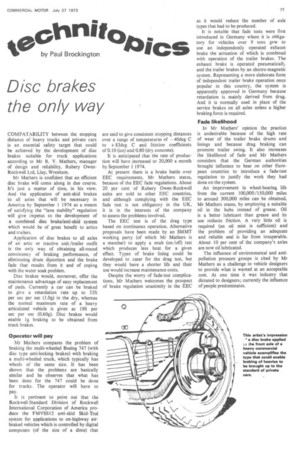teelin /Coto by Paul Brockington
Page 79

If you've noticed an error in this article please click here to report it so we can fix it.
Disc brakes the only way
COMPATABILITY between the stopping distance of heavy trucks and private cars is an essential safety target that could be achieved by the development of disc brakes suitable for truck applications according to Mr R. V. Mathers, manager of design and reliability, Rubery OwenRockwell Ltd, Llay, Wrexham.
Mr Mathers is confident that an efficient disc brake will come along in due course. It's just a matter of time, in his view. And the application of anti-skid brakes to all axles that will be necessary in America by September 1 1974 as a means of satisfying the. "lane stability" regulation will give impetus to the development of a combined disc brake/anti-skid system which would be of great benefit to artics and trailers.
Application of disc brakes to all axles of an artic or tractive unit /trailer outfit is the only way of obtaining all-round consistency of braking performance, of eliminating drum distortion and the brake fade that results from it and of coping with the water soak problem.
Disc brakes would, moreover, offer the maintenance advantage of easy replacement of pads. Currently a car can be braked to give a retardation rate up to 32ft per sec per sec (1.0g) in the dry, whereas the normal maximum rate of a heavy articulated vehicle is given as 19ft per sec per sec (0.60g). Disc brakes would enable lg braking to be obtained from truck brakes.
Operator will pay Mr Mathers compares the problem of braking the multi-wheeled Boeing 747 (with disc type anti-locking brakes) with braking a multi-wheeled truck, which typically has wheels of the same size. It has been shown that the problems are basically similar and he observes that what has been done for the 747 could be done for trucks. The operator will have to pay.
It is pertinent to point out that the Rockwell-Standard Division of Rockwell International Corporation of America produce the FMVSS12 anti-skid Skid-Trol system for applications to on-highway airbraked vehicles which is controlled by digital computers (of the size of a dime) that are said to give consistent stopping distances over a range of temperatures of —40deg C to + 83deg C and friction coefficients of 0.10 (ice) and 0.80 (dry concrete).
It is anticipated that the rate of production will have increased to 20,000 a month by September 11974.
At present there is a brake battle over EEC requirements, Mr Mathers states, because of the EEC fade regulations. About 20 per cent of Rubery Owen-Rockwell axles are sold to other EEC countries, and although complying with the EEC fade test is not obligatory in the UK, it is in the interests of the company to assess the problems involved.
The EEC test is of the drag type based on continuous operation. Alternative proposals have been made by an SMMT working party (of which Mr Mathers is a member) to apply a snub (on /off) test which produces less heat for a given effect. Types of brake lining could be developed to cater for the drag test, but they would have a shorter life and their use would increase maintenance costs.
Despite the worry of fade-test complications, Mr Mathers welcomes the prospect of brake regulation unanimity in the EEC as it would reduce the number of axle types that had to be produced.
It is notable that fade tests were first introduced in Germany where it is obligatory for vehicles over 9 tons gvw to use an independently operated exhaust brake the actuation of which is combined with operation of the trailer brakes. The exhaust brake is operated pneurnaticall5 and the trailer brakes by an electro-magnetic system. Representing a more elaborate form of independent trailer brake operation once popular in this country, the system is apparently approved in Germany because retardation is mainly derived from drag. And it is normally used in place of the service brakes on all axles unless a higher braking force is required.
Fade likelihood In Mr Mailers' opinion the practice is undesirable because of the high rate of wear of the trailer brake drums and linings and because drag braking can promote trailer swing. It also increases the likelihood of fade and Mr Mathers considers that the German authorities brought influence to bear on other European countries to introduce a fade-test regulation to justify the work they had done on the system.
An improvement in wheel-bearing life from the current 100,000/150,000 miles to around 300,000 miles can be obtained, Mr Mathers states, by employing a suitable oil in the hubs instead of grease. Oil is a better lubricant than grease and its use reduces friction. A very little oil is required (an oil mist is sufficient) and the problem of providing an adequate and reliable seal is far from insuperable. About 10 per cent of the company's axles are now oil lubricated.
The influence of environmental and antipollution pressure groups is cited by Mr Mathers as a challenge to vehicle designers to provide what is wanted at an acceptable cost. At one time it was industry that dictated to designers; currently the influence of people predominates.
























































































































































